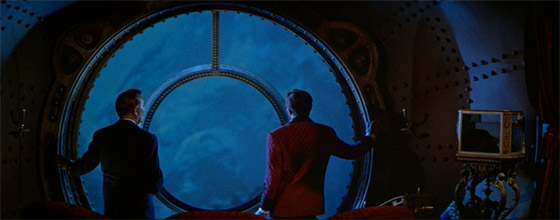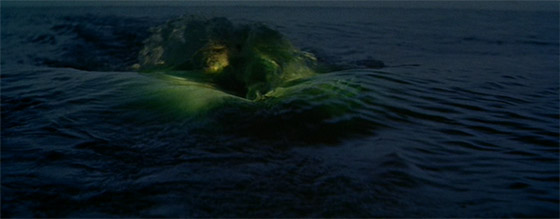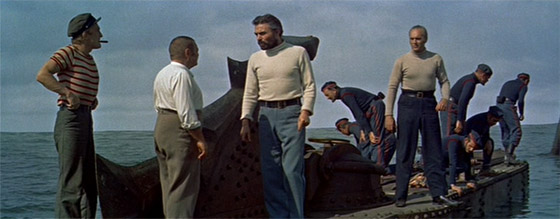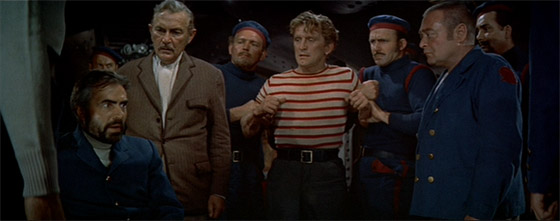 We typically put Disney movies in a category of their own; we exclude them from the greater world of twentieth century cinema, and discuss them only in the context of the history of the Walt Disney Company. Thus it’s often forgotten that 20,000 Leagues Under the Sea (1954) was, at the time, the most expensive film ever made, its costs surpassing Gone with the Wind, and threatening to ruin Walt if his product didn’t go over gangbusters with the general public. It was only the second film ever to be shot in anamorphic Cinemascope (only one Cinemascope lens was made available for shooting, thus extending the film’s production schedule and its budget). He enlisted an all-star cast with Kirk Douglas as Ned Land, Peter Lorre as Conseil, Paul Lukas as Professor Aronnax, and James Mason as Captain Nemo; and he hired the best Hollywood talent he could find, including cinematographer Franz Planer (Roman Holiday), production designer Harper Goff (Captain Blood), and editor Elmo Williams (High Noon). For director, he took a risk and hired Richard Fleischer, who had helmed one of the most exciting of film noirs, The Narrow Margin (1952), but had never tackled a big picture such as this. Fleischer was the son of animator Max Fleischer of Fleischer Studios, Disney’s rival back in the 20’s and 30’s. Richard sheepishly sought – and received – his father’s permission before accepting the job. The great success of the film allowed him to work steadily through the late 80’s; among his many notable films are The Vikings (1956), Barabbas (1961), Fantastic Voyage (1966), and Tora! Tora! Tora! (1970). For 20,000 Leagues, he shot on Disney backlots and soundstages – including a vast water tank constructed especially for the production – and filmed diving sequences off the coast of the Bahamas. Subtly fantastic but vividly convincing matte paintings were accomplished in-camera, sometimes by painting on glass and placing it strategically in the shot, and the result is a movie which looks like it was filmed all across the world, but also resembles a storybook illustrated by Howard Pyle or N.C. Wyeth. It remains one of the finest fantasy films ever made and hasn’t dated as much as you would think: a modern viewer might call it steampunk.
We typically put Disney movies in a category of their own; we exclude them from the greater world of twentieth century cinema, and discuss them only in the context of the history of the Walt Disney Company. Thus it’s often forgotten that 20,000 Leagues Under the Sea (1954) was, at the time, the most expensive film ever made, its costs surpassing Gone with the Wind, and threatening to ruin Walt if his product didn’t go over gangbusters with the general public. It was only the second film ever to be shot in anamorphic Cinemascope (only one Cinemascope lens was made available for shooting, thus extending the film’s production schedule and its budget). He enlisted an all-star cast with Kirk Douglas as Ned Land, Peter Lorre as Conseil, Paul Lukas as Professor Aronnax, and James Mason as Captain Nemo; and he hired the best Hollywood talent he could find, including cinematographer Franz Planer (Roman Holiday), production designer Harper Goff (Captain Blood), and editor Elmo Williams (High Noon). For director, he took a risk and hired Richard Fleischer, who had helmed one of the most exciting of film noirs, The Narrow Margin (1952), but had never tackled a big picture such as this. Fleischer was the son of animator Max Fleischer of Fleischer Studios, Disney’s rival back in the 20’s and 30’s. Richard sheepishly sought – and received – his father’s permission before accepting the job. The great success of the film allowed him to work steadily through the late 80’s; among his many notable films are The Vikings (1956), Barabbas (1961), Fantastic Voyage (1966), and Tora! Tora! Tora! (1970). For 20,000 Leagues, he shot on Disney backlots and soundstages – including a vast water tank constructed especially for the production – and filmed diving sequences off the coast of the Bahamas. Subtly fantastic but vividly convincing matte paintings were accomplished in-camera, sometimes by painting on glass and placing it strategically in the shot, and the result is a movie which looks like it was filmed all across the world, but also resembles a storybook illustrated by Howard Pyle or N.C. Wyeth. It remains one of the finest fantasy films ever made and hasn’t dated as much as you would think: a modern viewer might call it steampunk.

The Nautilus attacks.
When I was a kid, this was one of the first films I ever saw, or at least one of the first to be imprinted so permanently on my consciousness. I remember we rented a laserdisc player – always an event for us – and gathered excitedly around the only color TV in the house. As much as I loved the movie, it always seemed indigestible: impossibly long and episodic (and, thus, very Jules Verne). So I loved it in pieces. The sinking of the steamships by the Nautilus, which resembles a sea monster with glowing eyes. Kirk Douglas playing with the seal, Esmerelda. Nemo at his organ, looking tortured while he plays. The exploration of the ocean floor. The pursuit by cannibals. The attack of the giant squid. It sounds strange, but I always loved this brief bit which played on the Disney Channel in the 80’s (when we got cable, it was a big deal, and I watched the Disney Channel nonstop): it was a promo spot for the channel, which showed James Mason and Paul Lukas standing before the vast porthole as the window irises open, revealing the dark-blue depths of the ocean: “See how peaceful it is here,” James Mason says. That’s it. It’s still an awe-inspiring moment in the film, just as it is revealing of why Nemo does what he does. He sinks warships, but he also seeks isolation from the violence and chaos of the surface world. Having single-handedly invented the submarine, he gets the entirety of the ocean depths to himself. Peace at last.

Kirk Douglas, Peter Lorre, and James Mason stand astride the Nautilus. To maximize the anamorphic Cinemascope, few close-ups were shot.
Revisiting the film for the first time since the 80’s, I find the film to be nearly as wonderful as I left it. Yes, it is long: just over two hours, and just as episodic as I remembered. But, like Forbidden Planet (1956), it’s the rare fantasy film from this era with a handsome budget. It has the luxury to look as rich and sensational as a pulp paperback cover, or the detailed illustrations which accompanied each of Verne’s Les Voyages Extraordinaires. Disney actually hired an animator to bring to life deep-sea, phosphorescent fauna, but thankfully he left that footage on the cutting-room floor; he was able to achieve the fantastic through live action. As for the giant squid, it has its convincing moments, and is more an impressive achievement of editing than anything else. A stop-motion Ray Harryhausen beastie would have been nice, but for what’s essentially a gigantic puppet, Fleischer and his crew pull it off convincingly. (The entire sequence was reshot once they realized that filming the creature fully exposed in the light of a setting sun made it look ludicrous. The finished scene takes place during the chaos of a tempest, and is much more intense as a result.) The film is full of lush visuals, but thankfully is also perfectly cast. Douglas is at his robust prime, chewing the steel scenery charmingly, and to such an extent that when he bursts into song, it seems natural. Peter Lorre, won over to becoming his sidekick, is irresistible.

Paul Lukas, Douglas, and Lorre try to appeal to Captain Nemo's well-shielded heart.
But the star is truly James Mason – the best Nemo of the silver screen – who battles his inner monsters while driving his Nautilus through the keels of his enemies. The close-ups of his enraged face while he sends out his ship like a torpedo are genuinely chilling. He’s a murderer whose goal is world peace; James Bond wouldn’t know what to do with him. And as James Mason plays him, we want to like him, even as he pushes his three prisoners away. It’s an iconic performance for a film chock full of iconic moments and images. The 2-disc Disney DVD, featuring the film in anamorphic widescreen and 5.1 surround sound, is still on the market and highly recommended. A 90-minute documentary, narrated by John Rhys-Davies, features interviews with Douglas, Fleischer, Roy E. Disney, and members of the crew. Since the Disney vaults are vast, it’s a treat to see that they haven’t thrown much away: to every personal anecdote, accompanying behind-the-scenes footage supplements their stories, even finding a shot of the two Bahaman extras, dressed as cannibals, who painted on their heads “Eat at Joe’s” and “I Ate Joe.” The discarded undersea animation is presented as an extra, along with some of the original squid-attack footage, the short which preceded the theatrical release, and other fascinating ephemera.









